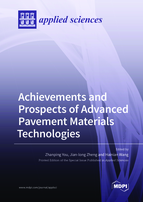Achievements and Prospects of Advanced Pavement Materials Technologies
A special issue of Applied Sciences (ISSN 2076-3417). This special issue belongs to the section "Materials Science and Engineering".
Deadline for manuscript submissions: closed (31 December 2018) | Viewed by 107623
Special Issue Editors
Interests: design, construction, and maintenance of pavements; micromechanics for road materials; discrete and finite element modeling techniques; construction materials: asphalt, aggregate; alternative and recycled materials for civil engineering
Special Issues, Collections and Topics in MDPI journals
Interests: asphalt mixture mechanical property; asphalt pavement design; special soil subgrade; road maintenance
Special Issues, Collections and Topics in MDPI journals
Interests: transportation materials; pavement design; asphalt mixture characterization and optimization
Special Issues, Collections and Topics in MDPI journals
Special Issue Information
Dear Colleagues,
Road transportation is a basic need for business, travel, and daily life. Currently, the distressing of pavement is still the main problem for maintenance. Therefore, it is important for us to conduct further research on pavement materials: 1) The improvement of pavement performance can be reached through pavement structure, materials and designs; 2) pavement models would help researchers to identify a better solution for pavement constructions; 3) pavement mechanics provide underlying views for mechanism analyses; 4) utilization of recycling materials is still a hot topic, and is a better solution for environmental issues; 5) maintenance and rehabilitation is still a challenge for the service life extension of pavement; 6) intelligent construction focuses on the project management, energy conservation and future constructions; and 7) innovative ways to test and evaluate the performance of pavement materials are expected.
The purpose of this Special Issue is to explore new research ideas for pavement materials. This issue aims to collect new pavement material technologies from different areas, which include but are not limited to, pavement materials mechanics, advanced tests, and recycling materials. This issue provides a platform for researchers to communicate and discuss new or emerging pavement material technologies.
All the papers will be peered reviewed. This journal is an open access journal and therefore a fee setup by the publisher will be charged which is not related to the guest editors.
Prof. Dr. Zhanping You
Prof. Dr. Jian-long Zheng
Prof. Dr. Hainian Wang
Guest Editors
Manuscript Submission Information
Manuscripts should be submitted online at www.mdpi.com by registering and logging in to this website. Once you are registered, click here to go to the submission form. Manuscripts can be submitted until the deadline. All submissions that pass pre-check are peer-reviewed. Accepted papers will be published continuously in the journal (as soon as accepted) and will be listed together on the special issue website. Research articles, review articles as well as short communications are invited. For planned papers, a title and short abstract (about 100 words) can be sent to the Editorial Office for announcement on this website.
Submitted manuscripts should not have been published previously, nor be under consideration for publication elsewhere (except conference proceedings papers). All manuscripts are thoroughly refereed through a single-blind peer-review process. A guide for authors and other relevant information for submission of manuscripts is available on the Instructions for Authors page. Applied Sciences is an international peer-reviewed open access semimonthly journal published by MDPI.
Please visit the Instructions for Authors page before submitting a manuscript. The Article Processing Charge (APC) for publication in this open access journal is 2400 CHF (Swiss Francs). Submitted papers should be well formatted and use good English. Authors may use MDPI's English editing service prior to publication or during author revisions.
Keywords
- advanced pavement materials;
- mechanics of pavement materials;
- recycling materials;
- materials for maintenance and rehabilitation;
- biomass derived asphalt,
- new rubber materials for pavement,
- sealant materials for pavement,
- nano modified materials for pavements








